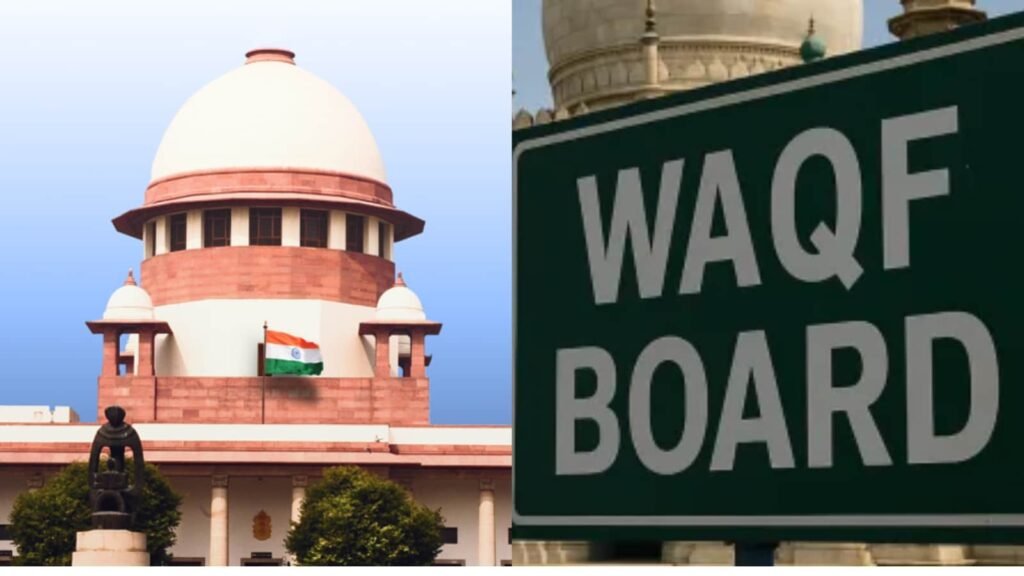UPSC CURRENT AFFAIRS – 05th April 2025
Evolution of Waqf in India
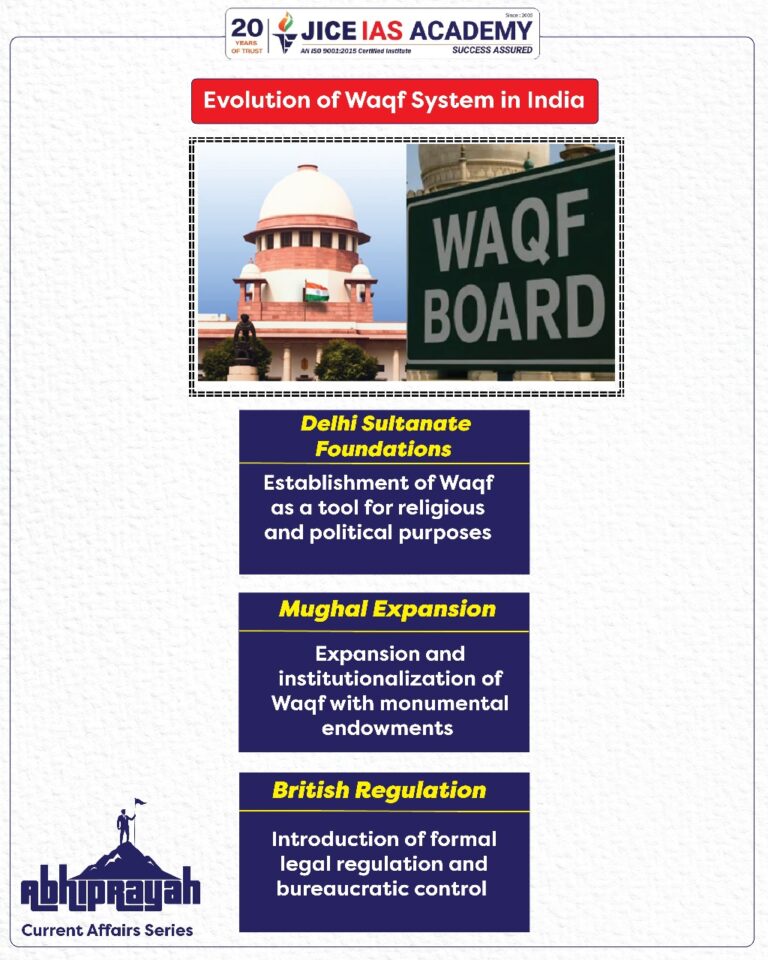
Why in News?
- The evolution of the Waqf system in India is being highlighted for its significance in religious, socio-economic, and political contexts across different historical periods—from the Delhi Sultanate to the British Raj.
- Waqf has functioned not only as a charitable and religious endowment system but also as a means of political assertion, urban development, and cultural integration over several centuries.
Key Highlights
- Waqf During the Delhi Sultanate (13th–16th centuries)
-
- The earliest recorded Waqf in India was created in the late 12th century, when a ruler dedicated village revenue in Multan to support a mosque—symbolising both religious devotion and political dominance.
- Waqf institutions proliferated under the Delhi Sultanate, with rulers and nobles endowing mosques, madrasas, khanqahs, and other public welfare facilities.
- These institutions significantly contributed to urban development by funding the construction of tombs, water reservoirs, graveyards, sarais (rest houses), and roads.
- Trustees (mutawallis) were appointed to manage Waqf properties, reflecting a structured administrative approach.
- The reign of Iltutmish marked a notable expansion, with the construction of major structures like the Shamsi Masjid in Badayun through Waqf funding.
- Waqf During the Mughal Period (16th–18th centuries)
-
- The Mughal era saw further institutionalisation of Waqf. Large-scale endowments were created for the maintenance of monuments, most notably the Taj Mahal.
- Waqf revenues from villages and markets were used to pay for ceremonial activities, salaries of caretakers, and religious commemorations.
- Mughal emperors patronised Sufi shrines, showing the deep interlinkage between Waqf, religious institutions, and imperial legitimacy.
- Waqf grants were also extended to non-Muslim beneficiaries, including Hindu priests, Sanskrit scholars, and temples, demonstrating religious inclusivity.
- Waqf Under British Colonial Rule
-
- Regulation XIX (1810 – Bengal): First regulation to supervise revenues from religious lands, applied equally to Hindus and Muslims.
- Regulation VII (1817 – Madras): Similar supervision of endowments for temples, mosques, and public utilities.
- Religious Endowments Act (1863): Ended direct British management of religious trusts; control given to local committees.
- Charitable Endowments Act (1890): Introduced “Treasurer of Charitable Endowments” to manage trust properties.
- Charitable and Religious Trusts Act (1920): Allowed public access to trust information and judicial oversight.
Waqf under British Rule
- Abdul Fata Case (1894): Declared family waqfs invalid unless truly charitable; applied English legal principles (e.g., rule against perpetuities).
- Mussalman Wakf Validating Act (1913): Legalized family waqfs (waqf-alal-aulad) with some charitable component. Advocated by M.A. Jinnah.
Mussalman Wakf Act (1923)
- Required mutawallis to maintain accounts and publish waqf records.
- Empowered civil courts for supervision but lacked an independent regulatory body.
- Provincial amendments added region-specific improvements.
Post-Independence Developments
Wakf Act (1954)
- Established State Waqf Boards for centralized management.
- Repealed prior laws (1863, 1890, 1920, 1923) and pre-1954 state waqf laws.
- Linked to managing evacuee properties left post-Partition.
Wakf (Amendment) Act (1984)
- Strengthened Waqf Boards and created Waqf Tribunals.
- Introduced committees and waqf commissioners for better oversight.
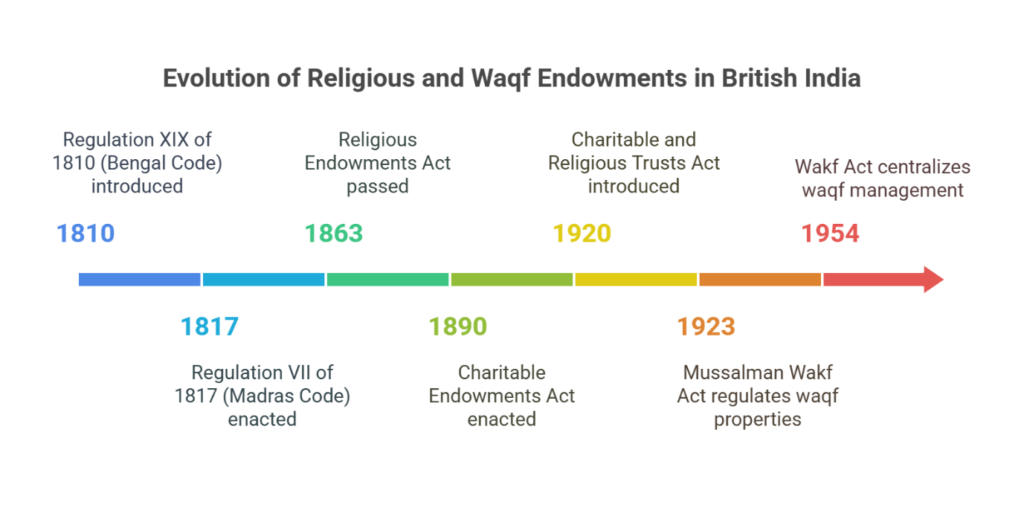
Important Concepts
- Waqf is a perpetual charitable endowment under Islamic law, through which income or property is permanently dedicated for religious, educational, or social welfare purposes.
- A khanqah is a Sufi religious retreat or hospice, supported by Waqf, that provides spiritual guidance and hospitality.
- A madrasah is an Islamic educational institution, often funded by Waqf, where students receive both religious and secular instruction.
- The Tareekh-e-Firauz Shahi is a Persian historical chronicle that records the creation, preservation, and expansion of Waqf institutions during the Delhi Sultanate.
Significance
- The Waqf system has played a crucial role in public service delivery, including education, health care, religious activity, and urban development.
- Waqf served as a tool of governance and legitimacy, helping rulers assert authority while fulfilling philanthropic objectives.
- The inclusion of non-Muslim communities as Waqf beneficiaries reflects the pluralistic and syncretic traditions of Indian society.
- The transformation of Waqf into a legally regulated institution under colonial rule shows how traditional systems adapted to modern administrative frameworks.
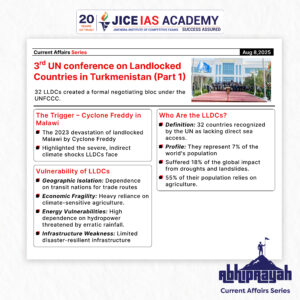
3rd UN conference on landlocked countries
UPSC CURRENT AFFAIRS – 08th August 2025 Home / 3rd UN conference on landlocked countries Why in News? At the

Issue of soapstone mining in Uttarakhand’s Bageshwar
UPSC CURRENT AFFAIRS – 08th August 2025 Home / Issue of soapstone mining in Uttarakhand’s Bageshwar Why in News? Unregulated
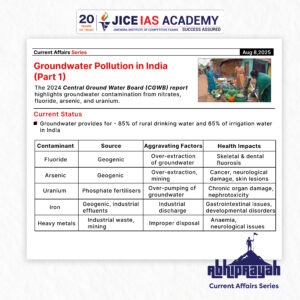
Groundwater Pollution in India – A Silent Public Health Emergency
UPSC CURRENT AFFAIRS – 08th August 2025 Home / Groundwater Pollution in India – A Silent Public Health Emergency Why
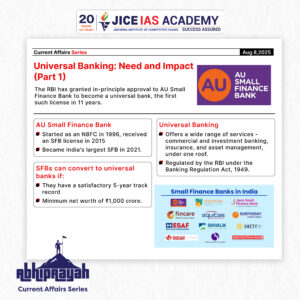
Universal banking- need and impact
UPSC CURRENT AFFAIRS – 08th August 2025 Home / Universal banking- need and impact Why in News? The Reserve Bank

India’s “Goldilocks” Economy: A Critical Appraisal
UPSC CURRENT AFFAIRS – 08th August 2025 Home / India’s “Goldilocks” Economy: A Critical Appraisal Why in News? The Finance

U.S.-India Trade Dispute: Trump’s 50% Tariffs and India’s Oil Imports from Russia
UPSC CURRENT AFFAIRS – 07th August 2025 Home / U.S.-India Trade Dispute: Trump’s 50% Tariffs and India’s Oil Imports from
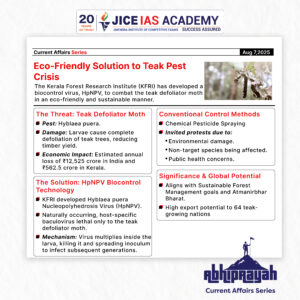
Eco-Friendly Solution to Teak Pest Crisis: KFRI’s HpNPV Technology
UPSC CURRENT AFFAIRS – 07th August 2025 Home / Eco-Friendly Solution to Teak Pest Crisis: KFRI’s HpNPV Technology Why in

New Species of Non-Venomous Rain Snake Discovered in Mizoram
UPSC CURRENT AFFAIRS – 07th August 2025 Home / New Species of Non-Venomous Rain Snake Discovered in Mizoram Why in

